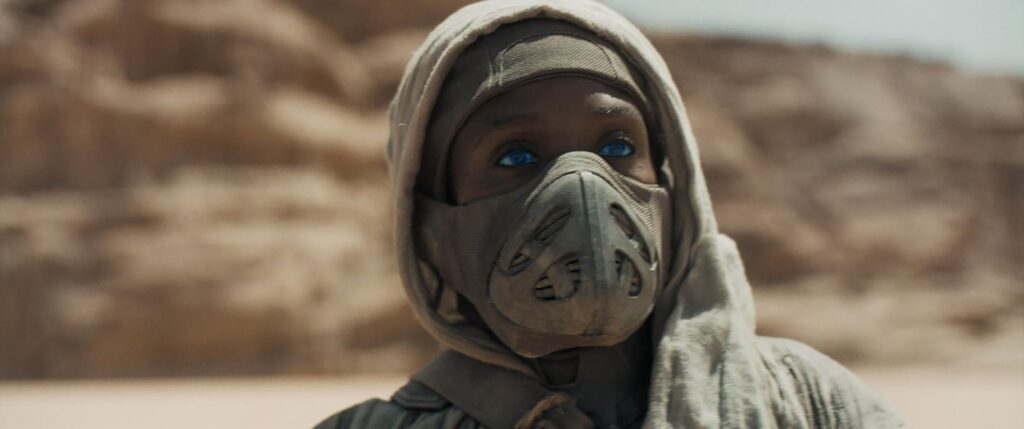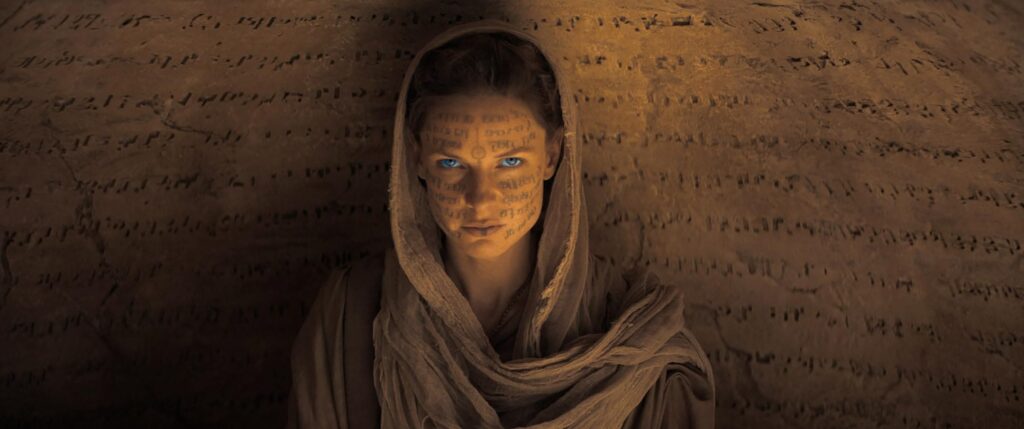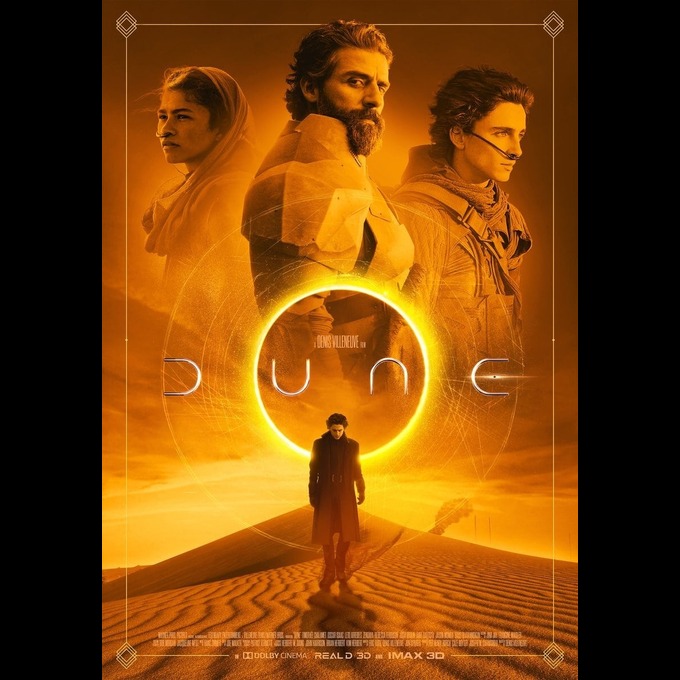Table of Contents
Cast:
Timothée Chalamet as Paul Atreides, Rebecca Ferguson as Lady Jessica, Oscar Isaac as Duke Leto Atreides, Josh Brolin as Gurney Halleck, Zendaya as Chani, Stellan Skarsgård as Baron Vladimir Harkonnen, and Dave Bautista as Glossu Rabban Harkonnen, Jason Momoa as Duncan Idaho, Javier Bardem as Stilgar, Sharon Duncan-Brewster as Dr. Liet Kynes, and Babs Olusanmokun as Jamis
Directors:
Denis Villeneuve
Producers:
Denis Villeneuve, Mary Parent, Cale Boyter, Jon Spaihts, Albert Cheng, Brian Herbert, Byron Merritt, and Kim Herbert
Executive Producers:
Philippe Rousselet, Richard Lewis, and Courtney P. Vaughan
Additional Crew:
Cinematography: Greig Fraser
Editing: Joe Walker
Music: Hans Zimmer
Production Design: Patrice Vermette
Costume Design: Jacqueline West
Plot
Welcome to Dune Review. In the far future, where humanity has abandoned AI and embraced psychic powers, the spice-rich desert planet Arrakis, also known as Dune, holds the key to interstellar power. It’s a harsh, unforgiving world dominated by colossal sandworms and the Fremen, fierce desert nomads. Duke Leto Atreides, a noble and just leader, accepts the stewardship of Arrakis, replacing the cruel Baron Harkonnen.

Though suspicious of the Emperor’s motives, Leto hopes to secure his family’s future and mine the precious spice, “melange,” a resource vital for space travel and heightened awareness.
Paul Atreides, Leto’s son, is a brilliant young man haunted by prophetic visions of Arrakis. He’s trained in swordsmanship and diplomacy but also possesses latent psychic abilities awakened by his Bene Gesserit mother, Lady Jessica.
Also read: Madame Web (2024): A New Superheroine Takes the Stage
This ancient Sisterhood manipulates genetics and bloodlines to achieve its goals, aiming to guide humanity to a better future. Paul’s visions hint at a bloody conflict and a messianic figure who will unite the Fremen against the oppressors.
Upon arrival at Dune, the Atreides are welcomed by the harsh desert reality. Monstrous sandworms, capable of swallowing entire buildings, lurk beneath the shifting sands. The Fremen adapted to survive in this unforgiving environment and observed the newcomers with cautious suspicion. Meanwhile, the Harkonnens, bitter at losing their fiefdom, conspire with the Emperor to betray the Atreides.
Treachery strikes like a sandstorm. Aided by the Emperor’s elite Sardaukar warriors, the Harkonnens launch a surprise attack. Duke Leto is killed, and Paul and Jessica barely escape into the desert with the help of Gurney Halleck, a loyal Atreides swordsman. They find refuge with the Fremen, who see Paul’s visions as a sign of their long-awaited messiah, Lisan al-Gaib.
Paul and Jessica must adapt to the Fremen’s way of life. They learn their harsh customs, their fierce loyalty to the desert, and their deep connection to the sandworms. Paul undergoes rigorous training in physical and mental combat under the tutelage of Stilgar, a Fremen warrior leader. Jessica, struggling to maintain her Bene Gesserit identity within the Fremen society, secretly trains Paul in the Sisterhood’s forbidden arts.
As Paul embraces his Fremen identity, his powers develop further. He hones his prophetic abilities and learns to control the sandworms, wielding them as weapons against the Harkonnens and the Emperor’s forces. Jessica’s training awakens Paul’s full potential, granting him access to the “voice,” a powerful psychic ability that can manipulate emotions and bend others to his will.
The conflict escalates into a full-blown war. Paul leads the Fremen in guerilla attacks against the Harkonnens, exploiting their superior knowledge of the desert and their newfound weapon: the sandworms. The Fremen’s resilience and Paul’s growing messianic status inspire rebellion across the galactic empire, threatening the Emperor’s iron grip on power.
In a final, climactic battle, Paul confronts Baron Harkonnen in a duel to the death. This brutal clash, infused with both sand and psychic fury, ends with Paul’s victory. However, the true battle lies within Paul himself. He grapples with the burden of his messianic role and the potential for his powers to unleash a reign of terror.
The film concludes with Paul ascending to the leadership of the Fremen, both messiah and warrior. He vows to protect the Fremen and their way of life, even as he navigates the treacherous political landscape of the galactic empire. His fate, and the fate of the galaxy, hang in the balance as he steps onto the path laid out by his visions, a path that could lead to both salvation and destruction.
Dune’s narrative is rich with complex themes and symbolism. It explores the dangers of unchecked power, the importance of ecological balance, and the seductive allure of messianism. The film also delves into the nature of identity, questioning whether we are shaped by our lineage, our environment, or our own choices.
This summary has only scratched the surface of Dune’s depth and complexity. The film leaves many questions unanswered, inviting audiences to ponder its themes and speculate on Paul’s future.
Dune is a journey into the heart of a harsh and unforgiving world, a world where sand and spice hold the key to both destruction and a brighter future. It’s a story that resonates long after the credits roll, leaving us questioning our own choices and the potential consequences of unchecked power.
Action Sequences
While Dune isn’t traditionally known as an action-packed blockbuster, it does feature several thrilling and visually stunning action sequences that contribute to the film’s overall impact. Here’s a breakdown of some key moments:

1. The Spice Harvester Attack:
This early scene sets the tone for the film’s brutal reality. We see giant harvester machines extracting spice from the sand, constantly under threat of the colossal sandworms.
A surprise attack by the Harkonnens, with Sardaukar warriors and aerial bombers, throws everything into chaos. The harvesters are crushed, men are slaughtered, and the sandworms rise in fury, swallowing both attackers and defenders alike.
This sequence is a masterclass in sci-fi action, combining practical effects with CGI to create a sense of overwhelming scale and visceral dread.
2. The Escape into the Desert:
Following the Atreide’s betrayal, Paul and Jessica flee on foot across the treacherous desert. They are pursued by Sardaukar soldiers and face the harsh elements, dehydration, and the ever-present threat of sandworms.
This scene is a tense and suspenseful cat-and-mouse chase, showcasing the harsh beauty of the desert and the characters’ desperation for survival.
3. Gurney Halleck’s Last Stand:
Loyal Atreides swordsman Gurney Halleck stays behind to buy Paul and Jessica time to escape. He faces off against a horde of Sardaukar in a brutal hand-to-hand battle, showcasing his incredible skills and unwavering loyalty.
Also read: Dune Part Two: Dive Deep into the Trailer and Beyond (2024)
This scene is a powerful display of heroism and sacrifice, adding an emotional punch to the film’s narrative.
4. Paul’s Visions and Training:
Throughout the film, Paul experiences intense visions of a coming jihad and his own messianic role. These visions are often accompanied by flashes of action, hinting at the battles to come.
Paul’s training with the Fremen includes intense physical and mental exercises, preparing him for the coming conflict. We see glimpses of his swordsmanship, hand-to-hand combat skills, and budding control over the sandworms.
These sequences are both visually striking and thematically important, foreshadowing the film’s larger conflicts and Paul’s transformation into a formidable leader.
5. The Final Battle:
The film’s climax sees Paul leading the Fremen in a desperate assault against the Harkonnens and the Sardaukar. They utilize their knowledge of the desert, their sandworm allies, and Paul’s growing psychic powers to overcome their seemingly insurmountable enemy.
This sequence is a visually stunning spectacle, showcasing large-scale battles, sandworm attacks, and Paul’s awe-inspiring display of power. It’s a satisfying payoff to the film’s build-up and leaves a lasting impression.
Dune’s action sequences are not simply gratuitous displays of violence. They are integral to the film’s story and themes, showcasing the characters’ struggles for survival, the brutality of war, and the potential for both destruction and redemption. The film’s masterful blend of practical effects and CGI creates a truly immersive and impactful experience, making these action sequences some of the most memorable in recent sci-fi cinema.
Character development
While Dune is known for its complex themes and expansive world-building, the character development, particularly in the 2021 film adaptation, is a nuanced and fascinating aspect worth exploring. Let’s delve into the transformations of some key characters:

1. Paul Atreides:
From sheltered prince to Fremen messiah, Paul starts as a young Duke’s son, sheltered and privileged. Visions and prophecies haunt him, hinting at a dangerous destiny.
Loss and betrayal fuel his growth. Witnessing his father’s death and family’s fall sparks a dramatic shift. He embraces the harsh Fremen life, honing his physical and mental skills.
Messianic burden and internal conflict: Paul’s visions and growing powers elevate him to a messianic figure for the Fremen. This burden weighs heavy, raising questions about his choices and potential for tyranny.
2. Jessica Atreides:
From Bene Gesserit manipulator to protective mother: Jessica initially uses her Bene Gesserit training to subtly influence events, shaping Paul’s future. Witnessing the chaos unfold forces her to prioritize her son’s safety above the Sisterhood’s agenda.
Adapting to survive and protect: Jessica sheds her Bene Gesserit cloak, embracing the Fremen’s ways to survive and protect Paul. This shift showcases her resilience and adaptability.
Letting go and trusting Paul’s path: Jessica grapples with the limitations of her control and ultimately lets go, trusting Paul to make his own choices, even if they deviate from the Bene Gesserit plan.
3. Duke Leto Atreides:
Just leader and noble sacrifice: Duke Leto is a noble and respected leader, known for his diplomacy and fair dealings. He trusts the Emperor and hopes to secure his family’s future on Arrakis.
Tragic betrayal and enduring legacy: His death at the hands of the Harkonnens is a turning point for the story, fueling Paul’s rage and solidifying his path toward rebellion.
Symbol of honor and sacrifice: Despite his tragic fate, Duke Leto’s legacy lives on through Paul, inspiring him to lead with justice and compassion.
4. Gurney Halleck:
Loyal warrior and mentor: Gurney is a fierce Atreides swordsman and loyal companion to Paul and Duke Leto. He trains Paul in combat and remains a trusted confidante.
Sacrifice for a greater cause: He stays behind to buy time for Paul and Jessica’s escape, showcasing his unwavering loyalty and willingness to sacrifice himself for those he cares about.
An embodiment of loyalty and courage: Gurney’s sacrifice serves as a powerful symbol of loyalty and courage, inspiring both Paul and the audience.
5. The Fremen:
From desert survivors to united tribe: The Fremen are initially portrayed as a divided and wary people. They observe the Atreides with suspicion, hesitant to trust outsiders.
Paul’s arrival and the promise of a messiah: Paul’s visions and leadership qualities unite the Fremen under his banner. He embodies their longing for freedom and becomes their messianic figure.
Transformation through shared struggle: The Fremen’s character development is intertwined with Paul’s. They grow stronger and more unified through their shared struggle against the Harkonnens and the Emperor.
Dune’s character development is subtle and nuanced, often unfolding through actions and reactions rather than explicit dialogue. The film masterfully portrays the characters’ internal struggles and transformations as they navigate a harsh and unforgiving world. Each character’s journey contributes to the film’s larger themes of power, choice, and the potential for both destruction and redemption.
Themes
Dune is a film rich in complex themes that explore humanity, ecology, and the perils of unchecked power. Here’s a closer look at some key themes:

1. Environmentalism and the Cost of Resource Exploitation:
Arrakis, the desert planet, is a harsh and unforgiving world dominated by the precious spice, melange. Its extraction fuels interstellar travel and heightened awareness, but the process is destructive, endangering the fragile ecosystem and the giant sandworms who are vital to its balance.
The film critiques the greed and short-sightedness of those who exploit resources without considering the long-term consequences. The Harkonnens’ reckless overharvesting of spice threatens the stability of Arrakis, mirroring real-world concerns about environmental degradation and resource depletion.
The Fremen, who have adapted to survive in harmony with the desert, offer a contrasting perspective. They respect the sandworms and understand the delicate balance of their ecosystem. Paul’s journey with the Fremen highlights the importance of ecological stewardship and living sustainably.
2. The Dangers of Unchecked Power and the Cycle of Violence:
The film depicts a galaxy ruled by a corrupt Emperor who manipulates and exploits others to maintain his power. The betrayal of the Atreides and the brutal subjugation of the Fremen are stark examples of the dangers of unchecked power and the devastating consequences of tyranny.
Paul’s rise as a messianic figure raises questions about the potential for even benevolent leaders to become dangerous. His visions of a bloody jihad and his growing psychic powers foreshadow the potential for his power to corrupt him.
The film suggests that true power lies not in domination, but in understanding and respecting others. Paul’s journey is ultimately about finding a balance between his power and his responsibility to protect the vulnerable.
3. Identity and Choice:
Paul’s journey is a quest for self-discovery. He grapples with his lineage as a Duke’s son, his Bene Gesserit heritage, and his emerging role as the Fremen’s messiah. He must choose who he wants to be and how he will use his power.
The film explores the idea that identity is not fixed, but rather shaped by our choices and experiences. Paul’s transformation from a sheltered prince to a Freemen warrior demonstrates how our environment and the choices we make can shape who we become.
The film also raises questions about free will and determinism. Paul’s prophetic visions seem to predetermine his path, yet he still makes choices that shape his destiny. This ambiguity leaves room for reflection on the nature of choice and the role of prophecy in our lives.
4. Faith and the Power of Belief:
The Fremen’s messianic belief in Paul fuels their rebellion against the Harkonnens and the Emperor. Their faith gives them hope and inspires them to fight for a better future.
The film explores the complex relationship between faith and power. Paul’s messianic status raises concerns about the potential for manipulation and fanaticism.
Ultimately, the film suggests that faith can be a powerful force for good, but it must be tempered with critical thinking and compassion. Paul’s journey is about finding a balance between faith and reason, using his power to uplift and protect rather than dominate.
These are just some of the many themes explored in Dune. The film’s richness and complexity invite viewers to engage in thoughtful discussion and interpretation long after the credits roll. It’s a film that leaves a lasting impression and continues to spark conversations about the challenges and possibilities facing humanity.
Direction
Denis Villeneuve’s direction of Dune in the 2021 film adaptation is masterful and deserves a closer look. Here are some of the key aspects that make his direction so impactful:

1. Visual Storytelling:
Creating a Visually Stunning Arrakis: Villeneuve crafts a breathtaking vision of Arrakis, capturing the desert planet’s harsh beauty and unforgiving nature. He uses wide shots to emphasize the vastness of the landscape and close-ups to showcase the intricate details of the sandworms and Fremen culture.
Immersive and Atmospheric: Villeneuve uses lighting, sound design, and slow-motion sequences to create a truly immersive experience. The constant threat of the sandworms is palpable, and the film’s overall atmosphere is one of tension and suspense.
Symbolism and Visual Metaphors: Villeneuve employs visual metaphors throughout the film, such as the sandworms representing both destruction and creation, and the Harkonnens’ chrome costumes symbolizing their cold and calculating nature.
2. Character Development through Action and Dialogue:
Action Sequences that Reveal Character: Villeneuve doesn’t rely solely on dialogue to develop characters. He uses action sequences to showcase their skills, motivations, and internal conflicts. Paul’s training with the Fremen and his climactic battle with Baron Harkonnen reveal his determination and growing power.
Nuanced Performances and Subtle Expressions: Villeneuve elicits powerful performances from his actors, with Timothée Chalamet’s subtle expressions and Rebecca Ferguson’s steely gaze speaking volumes about their characters’ inner struggles.
3. Pacing and Tension Building:
Balancing Scope and Intimacy: Villeneuve masterfully balances the film’s large-scale galactic setting with intimate character moments. He uses slow pacing in key scenes to build tension and allow the audience to absorb the weight of the characters’ decisions.
Masterful Use of Silence: Villeneuve understands the power of silence. He often lets the visuals and sound design speak for themselves, creating moments of profound emotional impact.
4. Themes and Subtext:
Visualizing Complex Themes: Villeneuve’s direction isn’t just about aesthetics; it’s also about conveying the film’s deeper themes. He uses visuals and symbolism to explore themes like environmentalism, the dangers of unchecked power, and the choices we make in shaping our identity.
Open to Interpretation: Villeneuve avoids spoon-feeding the audience. He leaves room for interpretation, inviting viewers to engage with the film’s themes and draw their conclusions.
In conclusion, Denis Villeneuve’s direction of Dune is a masterclass in cinematic storytelling. He creates a visually stunning and emotionally resonant film that stays true to the spirit of Frank Herbert’s complex novel. His attention to detail, masterful use of visuals and sound, and ability to balance large-scale action with intimate character moments make Dune a truly unforgettable cinematic experience.
Cinematography
The cinematography of Dune (2021) is a masterpiece of visual storytelling, weaving together breathtaking landscapes, haunting imagery, and nuanced symbolism to bring Frank Herbert’s epic sci-fi universe to life. Here are some key aspects that make it so impactful:

1. A Palette of Contrast:
Visceral Beauty and Crushing Aridity: The film paints Arrakis with contrasting brushes. Wide shots showcase the immense desert’s desolate beauty, and vast dunes stretching under a blazing sun. Close-ups reveal the harsh reality of life under the sand, the weathered faces of the Fremen, and the menacing presence of the sandworms.
Stark Contrast between Light and Shadow: Cinematographer Greig Fraser masterfully utilizes light and shadow to define the film’s power dynamics. The Atreides’ sun-drenched halls stand in stark contrast to the Harkonnens’ shadowy, chrome-plated interiors, reflecting their opposing ideologies.
2. Camera Movement and Framing:
Dynamic Sequences and Slow, Deliberate Movement: The camera dances with the sandworms in thrilling chase sequences, conveying the terror and awe of these colossal creatures. In contrast, slow pans across the desert landscapes and intimate close-ups on characters’ faces create a sense of contemplative stillness and introspective reflection.
Framing that Reflects Power and Vulnerability: Villeneuve and Fraser carefully frame their shots to emphasize the characters’ power dynamics. Paul’s journey is often framed with vastness, highlighting his initial naivety and vulnerability. As he embraces the Fremen’s way, the camera embraces him within the desert, showcasing his growing strength and connection to the land.
3. Symbolism and Visual Metaphors:
The Sandworm as Both Destroyer and Creator: These colossal creatures are not simply monstrous threats. Their presence symbolizes both the destructive and life-giving forces of nature. Close-ups of their glistening eyes and the way they churn the sand, creating fertile pockets of land, hint at their deeper ecological significance.
The Spice as Glimmering Allure: The shimmering spice, the source of interstellar travel and heightened consciousness, is depicted with a seductive glow. Close-ups of characters reaching for it reflect their desire for power and control, while also hinting at its potential dangers.
4. Technological Innovation and Practical Effects:
Blending CGI and Practical Effects: Villeneuve and Fraser seamlessly blend CGI with practical effects to create a believable and immersive world. The sandworms, while rendered digitally, feel physically present through their interactions with the environment and characters.
Large Format Photography: Shot on Alexa LF cameras, the film boasts a cinematic quality, capturing the vastness of Arrakis and the intricate details of its landscapes and costumes.
5. A Symphony of Color and Texture:
Desert Color Palette: The film’s color palette is dominated by earthy tones, reflecting the harshness of Arrakis. The sand’s shifting hues of gold, orange, and red evoke both beauty and danger.
Textural Contrast: Villeneuve and Fraser use textures to further define the film’s world. The smooth surfaces of the Atreides’ technology and the Harkonnens’ chrome contrast with the rough, organic textures of the Fremen’s clothing and desert environment.
In conclusion, the cinematography of Dune is not just visually stunning, but also deeply purposeful. It serves as a narrative tool, enriching the story with symbolism, reflecting power dynamics, and immersing the audience in the film’s unique world. It contributes significantly to the film’s overall impact, leaving a lasting impression on viewers long after the credits roll.
Music
The music of Dune (2021) is a powerful and evocative soundscape that plays a crucial role in immersing the audience in the film’s epic sci-fi world. Composer Hans Zimmer crafts a score that blends traditional orchestral elements with electronic and world music influences, creating a unique and unforgettable sonic experience.

Here are some key aspects of the music:
Themes and Motifs: The score is built around several distinct themes and motifs that represent different characters, locations, and ideas. The “Paul’s Dream” theme is a haunting melody that foreshadows his destiny and messianic role. The “Bene Gesserit” theme is a complex and layered piece that reflects the Sisterhood’s power and mystery. The “Ripples in the Sand” theme evokes the ever-present threat of the sandworms and the unpredictable nature of Arrakis.
Orchestral Power and Electronic Edge: The score seamlessly blends the grandeur of a traditional orchestra with the pulsing energy of electronic music. The strings and brass sections create a sense of epic scale and majesty, while the synthesizers and percussion add a layer of tension and danger.
World Music Influences: Zimmer incorporates elements of traditional Arabic and North African music into the score, reflecting the film’s desert setting and the Fremen culture. This adds a layer of authenticity and cultural richness to the soundscape.
Dynamic and Evolving: The music is not static; it adapts and evolves throughout the film to reflect the emotional and narrative shifts. The score can be quiet and introspective during character moments, then erupt into thunderous action sequences during battles and moments of high tension.
Some specific tracks that showcase the brilliance of the score include:
“Dream of Arrakis”: This opening track sets the tone for the entire film, introducing the vastness and mystery of the desert planet.
“Herald of the Change”: This powerful and driving piece accompanies Paul’s arrival on Arrakis and foreshadows the coming conflict.
“Gom Jabbar”: This tense and suspenseful track underscores the intensity of Paul’s test with the Bene Gesserit.
“Leaving Caladan”: This melancholic yet hopeful piece captures the emotion of the Atreides family’s departure from their home planet.
“Ripples in the Sand”: This iconic track perfectly captures the awe-inspiring and terrifying presence of the sandworms.
Hans Zimmer’s score for Dune is a masterpiece of modern sci-fi music. It is both powerful and nuanced, reflecting the film’s complex themes and emotions. It is a score that will stay with you long after the credits roll, reminding you of the epic journey through the harsh and unforgiving landscape of Arrakis.
Personal Opinion
I can share some of the positive and negative responses critics and audiences have had to the 2021 film “Dune” and offer some of my own thoughts based on the film’s qualities.

Positive aspects:
Visually stunning: The film’s visuals are universally praised for their grandeur and beauty. The desert landscapes, the sandworms, and the costumes are all meticulously designed and breathtaking to behold.
Rich and complex story: “Dune” delves into complex themes of ecology, politics, and religion, offering a thought-provoking experience that goes beyond simple sci-fi spectacle.
Strong performances: The cast delivers powerful performances, particularly Timothée Chalamet as Paul Atreides and Rebecca Ferguson as Lady Jessica. Their characters’ emotional journeys are compelling and relatable.
Hans Zimmer’s score: The score is equally lauded for its emotional impact and its ability to perfectly capture the film’s atmosphere and themes.
Negative aspects:
Slow pacing: Some viewers found the film’s pacing to be slow, especially in the first half. The deliberate build-up may not appeal to those who prefer a more fast-paced action experience.
Difficult to follow: The film’s complex plot and terminology can be challenging for viewers unfamiliar with the source material. Some may feel lost or confused at times.
Lack of character development: While the main characters are well-acted, some viewers felt that other characters, particularly the Fremen, could have been developed further.
My thoughts:
Despite some minor shortcomings, I believe “Dune” is a visually stunning and thought-provoking film that deserves its critical acclaim. The film’s strengths far outweigh its weaknesses, and its unique blend of sci-fi action, complex themes, and compelling characters makes it a truly memorable experience.
Ultimately, whether you enjoy “Dune” will depend on your individual preferences. If you appreciate slow-burning sci-fi epics with rich visuals and complex themes, then I highly recommend giving it a watch. However, if you prefer fast-paced action films with simple narratives, you may find it a bit underwhelming.
I encourage you to consider the various perspectives I have presented and form your own opinion on this impressive film.
Are the sandworms just giant monsters, or do they have a deeper ecological significance?
They’re both! Their presence represents the destructive and life-giving forces of nature. Their movements create fertile pockets in the desert, highlighting their role in Arrakis’ fragile ecosystem.
Are Paul’s visions glimpses of the future, or a product of Bene Gesserit manipulation?
The film leaves it ambiguous, forcing us to question the nature of prophecy and free will. His visions fuel his messianic role, but also raise concerns about potential manipulation and the dangers of unchecked power.
Is spice just a valuable resource, or does it represent a deeper societal critique of resource dependence and addiction?
It’s both. Its necessity for interstellar travel and heightened awareness symbolizes power and control. Its addictive qualities and the lengths people go to obtain it raise questions about greed and exploitation.
How does Hans Zimmer’s score blend traditional and modern elements to create a unique soundscape?
The score seamlessly merges the power of a full orchestra with the pulsing energy of electronic music. World music influences add a layer of authenticity, reflecting Arrakis’ desert setting and the Fremen culture.
Is Dune simply a visually stunning sci-fi adventure, or does it offer a deeper reflection on humanity, ecology, and the dangers of unchecked power?
It’s both. The film’s breathtaking visuals and thrilling action sequences transport us to Arrakis. But its exploration of complex themes and its nuanced characters make it a thought-provoking journey that stays with you long after the credits roll.
